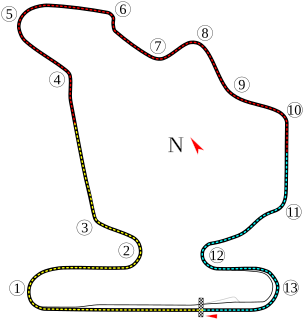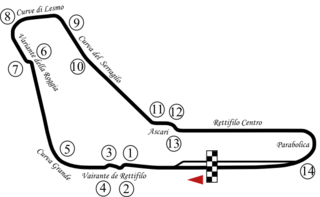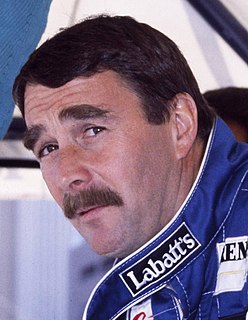The 1989 Canadian Grand Prix was a Formula One motor race held at Circuit Gilles Villeneuve on 18 June 1989. It was the sixth race of the 1989 Formula One World Championship.

The 1989 French Grand Prix was a Formula One motor race held at Paul Ricard on 9 July 1989. It was the seventh race of the 1989 Formula One World Championship.

The 1990 Hungarian Grand Prix was a Formula One motor race held at Hungaroring on 12 August 1990. It was the tenth race of the 1990 Formula One World Championship. The race was the sixth Hungarian Grand Prix and the fifth to be held at the Hungaroring. It was held over 77 laps of the 3.97-kilometre (2.47 mi) circuit for a race distance of 305.5 kilometres (189.8 mi).

The 1991 British Grand Prix was a Formula One motor race held at Silverstone on 14 July 1991. It was the eighth race of the 1991 FIA Formula One World Championship.

The 1992 Brazilian Grand Prix was a Formula One motor race held at Interlagos on 5 April 1992. It was the third race of the 1992 Formula One World Championship.

The 1992 San Marino Grand Prix was a Formula One motor race held at Imola on 17 May 1992. It was the fifth race of the 1992 Formula One World Championship.
The 1992 Canadian Grand Prix was a Formula One motor race held at Circuit Gilles Villeneuve on 14 June 1992. It was the seventh race of the 1992 Formula One World Championship.

The 1992 French Grand Prix was a Formula One motor race held at Magny-Cours on 5 July 1992. It was the eighth race of the 1992 Formula One World Championship.

The 1992 British Grand Prix was a Formula One motor race held on 12 July 1992 at Silverstone, Northamptonshire. It was the ninth round of the 1992 Formula One World Championship. The 59-lap race was won by Nigel Mansell for the Williams-Renault team, the Englishman also starting from pole position, leading every lap and setting the fastest lap of the race. Riccardo Patrese finished second in the other Williams car, with Martin Brundle third in a Benetton-Ford.

The 1992 Hungarian Grand Prix was a Formula One motor race held at Hungaroring on 16 August 1992. It was the eleventh race of the 1992 Formula One World Championship.

The 1992 Belgian Grand Prix was a Formula One motor race held at Spa-Francorchamps on 30 August 1992. It was the twelfth race of the 1992 Formula One World Championship.

The 1992 Italian Grand Prix was a Formula One motor race held at Monza on 13 September 1992. It was the thirteenth race of the 1992 Formula One World Championship.

The 1992 Australian Grand Prix was a Formula One motor race held at Adelaide on 8 November 1992. It was the sixteenth and final round of the 1992 FIA Formula One World Championship. The most significant moment was a collision between Ayrton Senna and Nigel Mansell as the Brazilian attempted to overtake the Englishman, eliminating both drivers. This was intended to be Mansell's final Formula One race before moving to IndyCars, although he returned briefly in 1994 and 1995.

The 1993 Australian Grand Prix was a Formula One motor race held at Adelaide on 7 November 1993. It was the sixteenth and final race of the 1993 Formula One World Championship.

The 1994 FIA Formula One World Championship was the 48th season of FIA Formula One motor racing. It featured the 1994 Formula One World Championship for Drivers and the 1994 Formula One World Championship for Constructors, which were contested concurrently over a sixteen-race series that commenced on 27 March and ended on 13 November. Michael Schumacher won his first Drivers' Championship driving for Benetton, while Williams-Renault won their third consecutive Constructors' Championship, the seventh in all for Williams.

The 1993 FIA Formula One World Championship was the 47th season of FIA Formula One motor racing. It featured the 1993 Formula One World Championship for Drivers and the 1993 Formula One World Championship for Constructors, which were contested concurrently over a sixteen-race series that commenced on 14 March and ended on 7 November. Alain Prost won his fourth and final Drivers' Championship, and Williams-Renault won their second consecutive Constructors' Championship, the sixth in all for Williams.

The 1992 Formula One World Championship was the 46th season of FIA Formula One motor racing. It featured the 1992 Formula One World Championship for Drivers and the 1992 Formula One World Championship for Constructors, which were contested concurrently over a sixteen-race series that commenced on 1 March and ended on 8 November. Nigel Mansell won the Drivers' Championship, and Williams-Renault won the Constructors' Championship.

The 1991 FIA Formula One World Championship was the 45th season of FIA Formula One motor racing and the 42nd season of the Formula One World Championship. It featured the 1991 Formula One World Championship for Drivers and the 1991 Formula One World Championship for Constructors, which were contested concurrently over a sixteen-race series that commenced on 10 March and ended on 3 November. Ayrton Senna won his third and last Drivers' Championship, and McLaren-Honda won their fourth consecutive Constructors' Championship. Senna won seven of the sixteen races; his main challenger for the title was Nigel Mansell, who won five races in his first season back at Williams. Senna's fierce rival Alain Prost failed to win a race with Ferrari and was fired before the end of the season due to a dispute with the team. 1991 also saw the debuts of future world champions Michael Schumacher and Mika Häkkinen, as well as the retirement of three-time champion Nelson Piquet.

The 1990 FIA Formula One World Championship was the 44th season of FIA Formula One motor racing. It featured the 1990 Formula One World Championship for Drivers and the 1990 Formula One World Championship for Constructors, which were contested concurrently over a sixteen-race series that commenced on 11 March and ended on 4 November. Ayrton Senna won in controversial circumstances the Drivers' Championship for the second time, and McLaren-Honda won their third consecutive Constructors' Championship.

The 1987 FIA Formula One World Championship was the 41st season of FIA Formula One motor racing. It featured the 1987 Formula One World Championship for Drivers and the 1987 Formula One World Championship for Constructors, which were contested concurrently over a sixteen-race series that commenced on 12 April and ended on 15 November. The World Championship for Drivers was won by Nelson Piquet, and the World Championship for Constructors by Williams-Honda. The season also encompassed the Jim Clark Trophy and the Colin Chapman Trophy, which were respectively contested by drivers and constructors of Formula One cars powered by naturally aspirated engines.
















